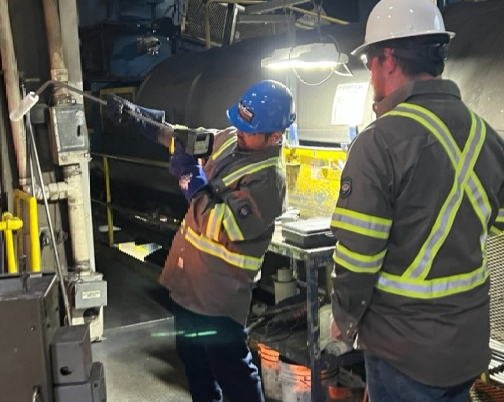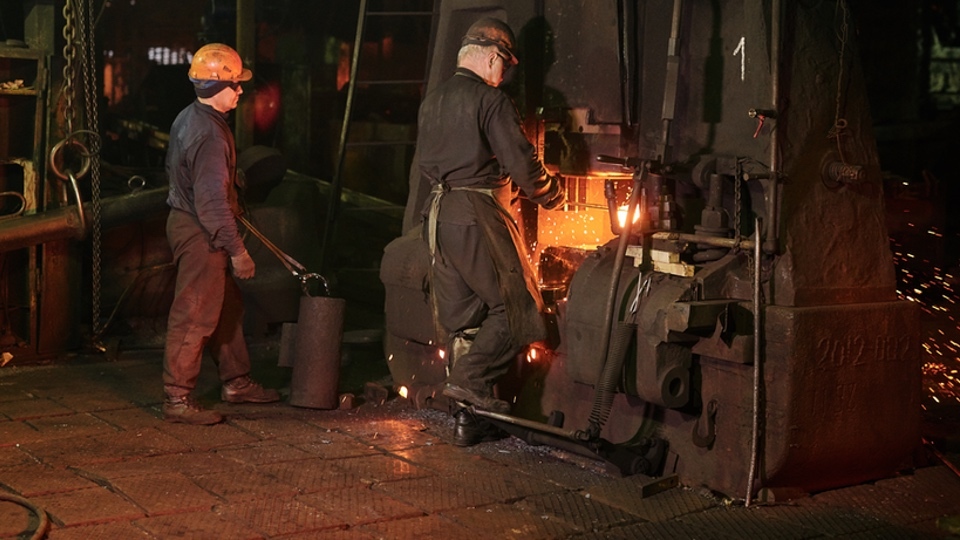The Role of Temperature Measurement in Foundries
In foundries, accurate temperature control is absolutely critical, as this profoundly impacts both the quality and efficiency of foundry operations. Two different kinds of pyrometers are used for temperature measurement: contact and non-contact. In this article, we’ll review factors impacted by temperature control, explore the differences between contact and non-contact pyrometers, and examine the pros and cons of each method of measurement.
Quality Assurance
In metallurgical processes, temperatures must be maintained with precision. Whether you’re melting, alloying, or casting, even small temperature variations can compromise the mechanical properties of the metal and lead to defects like shrinkage, porosity, or cracks in castings. Pyrometers provide the high level of accuracy that’s needed to assure consistent, high-quality results.
Productivity and Throughput
More accurate temperature control enables shorter cycle times and improved casting release, supporting higher productivity.
Resource Conservation
Accurate temperature control is one of the best ways to minimize waste. Maintaining correct temperatures helps ensure the right amount of metal is used for each casting and extends the lifespan of crucibles, refractories, and other equipment.
Energy Efficiency
Maintaining correct temperatures prevents overheating, allowing for more efficient energy consumption. This not only saves money but also helps minimize a foundry’s environmental impact.
Non-Contact Pyrometers
Non-contact pyrometers measure the temperature of molten metal without making direct contact with it. They rely on the following components:
Infrared Detector
As an object is heated, it emits infrared radiation, which is detectable as electromagnetic waves on the infrared spectrum.
Optical System
The optical systems use lenses or mirrors to focus incoming infrared radiation onto the detector.
Signal Processing
The detector generates an electrical signal proportional to the intensity of the infrared radiation it receives.
Temperature Calculation
The infrared pyrometer uses the intensity of the generated electrical signal to calculate the temperature of the object, using the Stefan-Boltzmann law, Planck's radiation law, or another radiation-to-temperature conversion formula.
Advantages and disadvantages
Some of the benefits of a non-contact pyrometer include:
- Non-contact pyrometers increase safety by eliminating the need for direct contact with molten metal.
- Non-contact pyrometers are non-intrusive, so they do not disrupt the process being measured.
- Because they can operate at a distance, non-contact pyrometers make it easier to measure the temperature of hard-to-reach or moving objects.
Non-contact pyrometers offer several advantages for foundries, but also have limitations:
- Non-contact pyrometers rely on the emissivity of the object, which is a measure of how efficiently an object emits infrared radiation. Variations in emissivity can lead to measurement errors.
- Since they do not come in contact with the object, non-contact pyrometers can only measure surface temperatures.
- Non-contact pyrometers can be affected by smoke, fog, dust, and other particles in the air.
Contact Pyrometers
A contact pyrometer, on the other hand, measures the temperature of molten metal using a sensor that comes into direct contact with it and applying the principles of thermal conductivity.
Thermocouple
The thermocouple contains two dissimilar metals that produce an electric charge when heated. When the pyrometer comes in contact with an object, the two metals produce a current proportional to the temperature of the object.
Probe
A probe is the part of a thermocouple that comes into direct contact with the object being measured.
Galvanometer
The galvanometer measures the electrical current produced by the thermocouple and converts it into a temperature reading.
Advantages and disadvantages
In foundry environments, contact pyrometers are often the better choice for several reasons:
- Because they come into direct contact with the metal, contact pyrometers provide more accurate temperature measurements.
- Issues caused by slag, emissivity, and surface temperature variations are eliminated when using immersion thermocouples.
- Contact pyrometers are more durable, built to withstand harsh foundry environments.
- Contact pyrometers provide rapid readings, empowering personnel to adjust temperatures in real time to prevent defects and maintain more consistent product quality.
- Contact pyrometers are relatively straightforward and easy to operate, even with minimal training, making them accessible to a wider range of users.
While contact pyrometers with immersible thermocouples are almost always a better choice for molten metal applications, these issues should also be acknowledged:
- Contact pyrometer instruments are generally more expensive than infrared units.
- Immersion thermocouples must be replaced frequently, leading to substantially higher operating costs.
Pyrometer Applications in Foundries
Pyrometers use a variety of data, including emissivity factors and surface slag interference, in temperature measurement. The result is an extremely accurate temperature, providing all the essential information needed for foundry applications. While contact pyrometers offer serious advantages over non-contact units, pyrometer accuracy can vary quite a bit depending on the application. This makes it critical to choose the right instrument for the job.
SYSCON Sensors provides state-of-the-art molten metal temperature analysis sensors. We’ve been in the industrial business since 1975, crafting high quality instrumentation designed to deliver the most accurate readings possible. With nearly five decades of experience behind us, we’ve now partnered with a new organization that is wholly dedicated to bringing our products directly to our customers. You can always count on SYSCON Sensors for your molten metal analysis needs.



